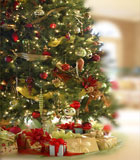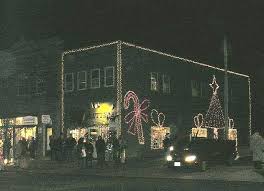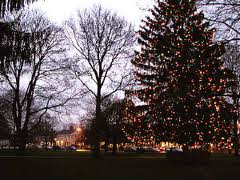Village Greene Gardens, helping you grow since 2011.
2392 Boston Post Rd. (Rt.1) Guilford--203-453-1818 (Text only 203-859-1005)
Open M-F 8a-5p, Sat./Sun 9-5*12/24 8-1,Closed 12/25 + 12/26(Quick way-Exit 57)
Village Greene Gardens, helping you grow since 2011.



2392 Boston Post Rd. (Rt.1) Guilford--203-453-1818 (Text only 203-859-1005)
Open M-F 8a-5p, Sat./Sun 9-5*12/24 8-1,Closed 12/25 + 12/26(Quick way-Exit 57)
SPRING IS FINALLY HERE!
By Leigh, Your Village Horticulturist.
It’s April, and the landscape is awakening. Lawns are brightening, and the emerging leaves of trees and shrubs are a special fresh shade of green. Bulbs and perennial plants are sprouting out of their winter dormancy. As exciting as it is to see the daily changes, it’s easy to feel overwhelmed by the thoughts of maintenance. Take a few minutes to walk through your outdoor living spaces. Take some photos and make some notes about what you see, and what you envision. Having a simple plan can help you prioritize tasks, save maintenance and planting time, and allow you more hours to relax and enjoy your yard.
Repairing winter damage should be the first item on your list. Snow plow damage needs to be raked out and levelled. Soil may need to be added to fill ruts, and fresh seed should be planted. The area under your bird feeder should be raked clean of seed hulls and debris. Broken branches on trees and shrubs should be removed, and corrective pruning can be done now. If not already done, the dead stems of perennials should also be cut at this time, allowing space and light for this year’s shoots.
Next comes the fun of planting! April is still early for many of the annual flowers, but perennials, trees, shrubs, pansies and early vegetables can readily be planted. Again, a plan of what you envision will help streamline the time spent selecting and planting. If you haven’t already started, consider planting some native plants in your landscape. They are adapted to our Connecticut climate, and support pollinators and wildlife.
Don’t forget to include mixed planters as a source of easy all season color for your steps, deck, or patio. Let your imagination run as you consider these. They may be herbs, vegetables, tropical plants, flowers….plant your own in a decorative planter, or find a custom, already beautiful and full design.
To find specific, detailed plant information, fun things to do in the yard, and chores that need to be done at this time, visit www.villagegreene.net. This new resource lists hundreds of plants.
Finally, enjoy your time outside! Time spent to get a good start and strong foundation early in the season will reward you with leisure time in a comfortable outdoor space through the summer and fall.
Snow in the Landscape by Leigh, The Village Horticulturist
The weather forecast is for several inches of snow overnight. Did you groan…or feel a little anxiety? After
all there are those logistical issues: school delay? When will my neighborhood be plowed out? How much
extra time must I plan for my commute? Everything is just a bit more complicated. But our gardens are
saying YES!
Snow cover, with only a few exceptions, is a great benefit to your landscape. Snow acts as an insulating
blanket, regulating soil temperature. During an “open winter” (no snow cover) the soil is subject to
freeze/thaw cycles. Prolonged freezing temperatures penetrate deep into the ground, potentially
damaging the roots of plants. Add in a warming cycle, and the soil can frost heave, breaking and exposing
roots, drying them out, and subjecting them to the next freeze cycle. Under a snow blanket, the soil
temperature remains constant.
Snow also recharges our surface water and aquifers. It generally provides for a slow percolation of water
into the soil over the course of the winter and early spring. This moisture is critical for evergreens, which
continue to photosynthesize during the winter. Deciduous plants also benefit from the available
moisture and nutrients.
Seed stratification, the cool moist process to breaking a seed’s dormancy, is aided by good snow cover.
The weight of the snow ensures good seed contact with the soil. Both of these factors are important
parts of the propagation of our native plants.
Snow also has aesthetic benefits. It absorbs sound and reflects light, resulting in a quieter and brighter
landscape. The varied colors of evergreens are highlighted against the white backdrop. The colors of the
branches and twigs of deciduous plants are evident, and these change over the course of the winter.
Snow highlights the bones of the garden: the paths, statuary and ornaments, benches, furniture and
structures.
There can be a few drawbacks to the snow cover. Heavy, wet snow can damage and break branches. If
possible, carefully lifting and removing this snow can mitigate damage. Deep snow for an extended
period of time can result in increased damage from herbivores. Small mammals, mice and voles, are
protected from predators and have a network of tunnels under the deep snow. Gnawing on bark of
shrubs and feeding on fleshy roots of perennials can result in damage to your landscape. Deer, also, are
more likely to seek out your ornamental landscape in a winter of deep snow.
So, the next time the forecast is for a few inches overnight, think of the benefits for your landscape
before you start to plan your day!
Houseplants Beyond the Home (By Katherine @ Village Greene Gardens)
Thick, practically opaque fog obscures my path. I glance down as I struggle to secure my footing and am shocked to see what lays at my feet: spiders. Massive spiders presiding over their innumerable babies. Every surface is teeming with them, save for a sparse few spaces, for instead of spiders, those areas are occupied by snakes. Snakes of all kinds, coiling, climbing, slithering, even raising up and standing to meet my eye line. However my gaze travels onward and upward, above the snakes, through the mist, and I can faintly make out faces– monkey faces, hanging poised from their perches. Just beyond them, slivers of light beam through the branches and illuminate the silhouette of enormous elephant ears. No, this is not an account of my latest jaunt through the jungle, but a description of my living room as the morning sun wakes and gently wraps her rays around my spider plants (Chlorophytum comosum) and snake plants (Dracaena trifasciata) while my humidifier softly mists my monkey face plant (monstera adonsonii) and my elephant ears plant (alocasia). Houseplants add not just beauty to our home; they have incredible benefits to our health and well being. However, this article will focus on a lesser known aspect of houseplants: their ability to connect us with others and strengthen friendships, especially while being cooped up because of corona.
The sun comes up, I sit listlessly on my couch, I stare at my houseplants, and the sun goes down. The sun rises, I water my plants, and the sun sets. Day in and day out. The sun rises, but this time, one of my Monstera’s leaves is yellow. I look online for the possible cause, read website after website, and I finally deduce it’s from either overwatering, under-watering, too much light, too little light, too much humidity in the air, or not enough. So, still stuck at square one, I try a new strategy and consult Facebook. I join a few plant groups, take a picture of my plant, and make a post asking for advice. Within five minutes, Sara in Houston comments that she had the same problem and that my Monstera needs a bigger pot. Cyril in France agrees and adds that they are happiest in terra cotta pots. And lastly, Ira in Indonesia tells me how propagating Monsteras is fun and easy, suggests I give it a try, and wishes me luck. And here lies the unique beauty of houseplants; In contrast to outdoor planting, which is zone-specific and seasonal, the same houseplants are found year-round in homes across the globe. Soon I began commenting on other posts and before I knew it, I was recognizing faces and had become part of a community. People from all over the world, all stuck in quarantine, had the same plants—and problems– as I did. And we helped each other through it. Together we turned our isolation into an oasis.
I took Ira’s advice and began propagating my Monstera, but it didn’t stop there. I began propagating any and every houseplant that I could. I popped some of my spider babies and pothos cuttings in water and within days they had began to grow roots! My first experiment was a success! But now that I had all these baby plants, I wasn’t sure what to do with them. So I called my friend who told me how her Chinese money plant (pilea) had recently produced pups and she suggested we exchange. I jumped at the opportunity, jumped in my car, and drove to her house. Her baby pilea was waiting for me outside and I left my rooted cuttings on her front porch. (We arranged this contactless tradeoff to Avoid spreading covid.). Word of our little exchange spread throughout our group of friends and that’s how I went from having 10 different houseplants to having 25. Propagating houseplants was a not just a new hobby for my friends and I, it was something to look forward to everyday, something new and interesting to learn more about. It was a reason to call up a friend just to chat, even on the darkest days of isolation. Like me, they enthusiastically shared not only tricks on how to pass the time, but also picture of new, unfurling leaves. Like me, they anguished not only over the uncertainty of the future, but also the uncertainty of why their leaves were browning. Like me, their love of houseplants and sense of community grew because of corona. And like me, their houseplants extended far beyond the home.
Enjoy the birds! By Leigh, your Village horticulturist.
It is November. Days are getting shorter and colder. Nights are long, and colder. Birds have few daylight hours in which to find seeds, fruit, and a few insects to sustain them through the night. Even if you have planned your landscape and garden to provide shelter, water, and food producing plants, supplemental feeding is still recommended. Most songbirds, during the spring and summer, have a diet that is largely insect based. This food supply is usually abundant, and highly nutritious. With the onset of fall and winter, seeds and fruits become the main source of food for both the migratory and permanent resident birds. During these seasons, backyard feeders can help to sustain bird populations. What to feed? Certainly, providing a mix of seeds, fruit, and suet cakes will attract a diversity of species, but there are several key foods that one may want to purchase. In our region, black-oil sunflower seeds attract the greatest number of species. They are nutritious and high in fat, providing a good energy source. They have a high meat- to- shell ratio, and shells are easily cracked by both small and large birds. “Nijer” or thistle seed is the preferred seed for finches. Because it is small and somewhat expensive, it is best to provide this seed in a special nijer feeder, rather than including it in a feeder of mixed seed. Safflower seed is preferred by cardinals and grosbeaks, and is rarely eaten by squirrels. It can be fed separately, or mixed into your sunflower seed to discourage squirrels and starlings from visiting your feeder. Ground feeding birds, such as doves, prefer cracked corn and white millet. Both of these seeds are generally found in a good quality seed mix, and seed that falls from the feeder is readily eaten. Woodpeckers, chickadees, and nuthatches (insect eating birds) appreciate the high energy suet cakes that often contain additional bird seed or fruit. The cakes do not go rancid, and can be fed year round. Feeders should be placed close enough to trees and shrubs to provide cover and shelter for the birds, but far enough away (10’) to prevent jumping off places for squirrels and cats. Feeders should be kept clean, and the hulls and seeds that collect beneath your feeder should be raked up every few weeks. Water is as important for birds in winter as it is in summer. Using two round cake pans will allow you to fill one each day, bringing in the second one to thaw during freezing temperatures. Most garden center have a broad selection of feeder types to accommodate your choice of seed. They carry black oil sunflower, a general mixed seed, and a full supply of Lyric Seed Mixes. These seed mixes have been preference tested, so that there is no waste, and no noxious weed seed. You can choose from specific formulations (ie: cardinals or woodpeckers), or single seed, such as golden safflower. While you are enjoying watching the birds from the warmth inside your home, take some time to plan your garden to help attract more birds and pollinators this spring and summer. Our horticulturists are available year round to assist with your garden plans, and offer suggestions for your landscape. Lastly, consider Citizen Science and participating in one of the feeder counts. CT Audubon Society and Cornell Laboratory of Ornithology have annual feeder counts to help monitor the population trends of our avian friends.
Plant Now for Spring Color. By Leigh, The Village Horticulturalist.
As we head deeper into the fall season, there is still time to plant most perennials, shrubs, and trees. The plants will continue to
make roots until the ground freezes and be ready to jump start into growth in the spring.
But, if you’re looking for an extra early, colorful, and easy start to spring, consider planting bulbs this fall. Bulbs are reliably hardy,
and create a colorful show for a relatively small expenditure of time and money.
There are a few basic guidelines that pertain to all of the commonly planted bulbs: 1) provide well drained soil 2) follow the rules
of three-the depth of the planting hole should be three times the height of the bulb, and, plant in a minimum of three bulbs to a
group (larger clumps or drifts are more showy) 3) be sure the pointed end of the bulb is up 4) provide at least a half day of sun
for most species.
First to bloom are many of the minor bulbs: crocus, snowdrops, grape hyacinths and scilla. While these all require sun, their early
growth and bloom is before most deciduous plants leaf out, so they can be easily incorporated into perennial borders and woodland gardens. They are deer and rabbit resistant.
Daffodils are widely recognized as a herald of spring. There are more than 32,000 registered cultivars, with colors ranging from
pure white to solid yellow to multicolored white with orange cup, yellow with orange cup to a peachy/pink. Flowers, on stems
ranging from two inches to two feet, may be single, double, or multiple blooms per stem. Truly perennial, these bulbs will multiply, spread, and naturalize. Because they are so reliable, they are a great bulb for children to plant, as success is almost guaranteed!
The most elegant of our common bulbs is the tulip. It’s broad range of flower color is further enhanced with bi-colored and frilly
petaled flowers. Similar to daffodils, tulips range in height from 2 inches to 2 feet. Tulips require a bit more care at planting.
While the bulbs have enough stored energy for their first year’s bloom, an addition of an organic fertilizer at planting time ensures that the bulbs have enough energy to bloom a second (or more) year. Deadheading also allows the plant to put energy into
the bulb, rather than producing seed. As these are relished by deer, a good repellent spray should be regularly applied as soon as
the foliage emerges in spring. True of all bulbs, allow the spent foliage to yellow if you choose to remove it from your garden bed.
So, plant now for a bright and colorful spring!